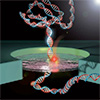| Feb 05, 2025 |
|
(Nanowerk News) A gate that can be open or shut to allow or block the passing of species on one or both sides applies not only on the macroscale, for example a farm gate used to control stock movement, but also at the nanoscale, where a gate can control the translocation of single molecules.
|
|
A collaboration headed by researchers at Osaka University has developed a nanogate that can be open or shut by applying electricity (Nature Communications, “Transmembrane voltage-gated nanopores controlled by electrically tunable in-pore chemistry”). The nanogate shows various behaviors depending on the materials in the solutions on both sides of the gate and the applied voltage, making it attractive for different applications including sensing and controlled chemical reactions.
|
|
The nanogate consisted of a single nanopore that was formed in a silicon nitride membrane. The membrane was positioned in a flow cell formed on a chip and solutions were introduced on both sides of the membrane. The researchers applied voltage to the flow cell via electrodes on the chip, and measured the resulting ionic current, which reflected the transport of ions through the pore. The ionic current was sensitive to the ions in the solutions on both sides of the membrane; thus, the flow of ions and the resulting precipitation or dissolution of metal compounds in the pore could be precisely controlled.
|
 |
| Schematic model depicting single molecule DNA translocating through a nanoprecipitated nanopore. (Image: Makusu Tsutsui)
|
|
The change of pore diameter resulting from precipitation (which closed the nanogate) or dissolution (which opened the nanogate) led to distinct types of ion transport. “Precipitates grew and closed the pore under negative voltage, decreasing ionic current,” says lead author of the study, Makusu Tsutsui. “Inverting the voltage polarity caused the precipitates to dissolve, reopening the pore.”
|
|
Under certain conditions, the formation of a precipitate that blocked the pore resulted in the highest rectification ratio, which is a measure of the propensity of ions to travel only in one direction, achieved to date for a nanofluidic device. As well as acting as a rectifier, the system could also behave as a memristor; that is, a memory effect was observed in its relationship between current and voltage. The sequential precipitation and dissolution of materials in the pore led to this memristive behavior.
|
|
Additionally, in-pore reactions could be regulated to allow biomolecule detection. This was demonstrated using DNA. The system exhibited distinct output signals as individual DNA molecules moved through the pore.
|
|
“The ability to finely control pore size using applied voltage should allow pores to be tailored for specific analytes immediately before conducting measurements,” explains senior author Tomoji Kawai. “We also anticipate that our approach can be used to develop reaction systems to access new chemical compounds.”
|
|
Using a membrane with a single controlled pore in nanofluidic electrochemical devices is a versatile approach that can be tailored for specific applications including sensing, chemical reactions, and neuromorphic computing.
|


